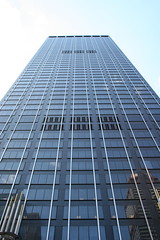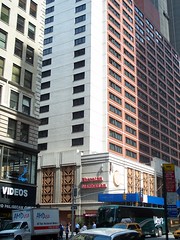South:Corner (834 8th Ave): Capital Apartments, built 1925 Paramount Plaza Corner (1633 Broadway): Originally known as the
Uris Building, this 48-floor building went
up in 1970 on the site of the
Capitol Theatre, demolished in 1968. The 1919
cinema was designed by Thomas Lamb and was managed
for a time by Samuel "Roxy" Rothapfel. It originally sat 5,300,
making it the largest cinema in New York at the time and probably
the world. It was the flagship of MGM's cinema chain; The Wizard
of Oz and Gone With the Wind both opened here
in 1939. The talent show Major Bowes' Original
Amateur Hour, a huge phenomenon in its 1930s heyday,
was broadcast from here on CBS Radio. The last movie to play here was 2001.
Corner (1633 Broadway): Originally known as the
Uris Building, this 48-floor building went
up in 1970 on the site of the
Capitol Theatre, demolished in 1968. The 1919
cinema was designed by Thomas Lamb and was managed
for a time by Samuel "Roxy" Rothapfel. It originally sat 5,300,
making it the largest cinema in New York at the time and probably
the world. It was the flagship of MGM's cinema chain; The Wizard
of Oz and Gone With the Wind both opened here
in 1939. The talent show Major Bowes' Original
Amateur Hour, a huge phenomenon in its 1930s heyday,
was broadcast from here on CBS Radio. The last movie to play here was 2001.

Now houses the U.S. offices of Hachette Filipacchi, the world's largest magazine publisher; several of their American magazines are based here, such as Elle, Woman's Day and Premiere. Located in the sunken courtyard is Din Tai Fung, the largest branch of an acclaimed Taiwanese dumpling chain. Formerly in the space was Mars 2112, a touristy sci-fi-themed restaurant. |
W
|
North:255: Invite Health; Vasili Shoe Repair 253: EC Professional Video 251: Siam Inn, hotel; includes Blue Chili, Thai Times Square Church237: This church was founded in 1986 by David Wilkerson, author of The Cross and the Switchblade, to minister to the "prostitutes and pimps, runaways, drug addicts and hustlers" of the old Times Square; it moved here in 1989. It was originally built in 1930 as the Hollywood Theatre, designed by Thomas W. Lamb in a French baroque style as the first cinema made specifically for talkies. (Casablanca bowed here in 1942.) As the Mark Hellinger Theatre, a legit Broadway house named for a columnist turned movie producer, it saw the premieres of My Fair Lady with Julie Andrews, A Funny Thing Happened on the Way to the Forum, On a Clear Day You Can See Forever and Jesus Christ Superstar. The auditorium is well preserved and has been called the last surviving movie palace in the Times Square area. Corner: After leaving Lindy's restaurant on April 5, 1956, Victor Riesel, a reporter who had been covering labor racketeering, had acid thrown in his face at this corner by small-time thug Abraham Telvi. Riesel was blinded but kept writing; Telvi was rubbed out two weeks later. |

